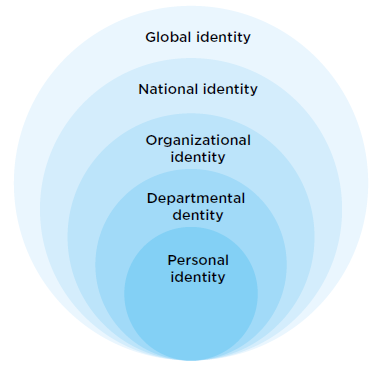Magnifying Microcultures: When Employees Follow Peers, Not Companies

Image Source – Freepik
The individual is always part of something bigger. We cannot ignore that much of our self-concept is shaped by the groups we belong to, influencing us through shared norms, values, symbols, practices, and even the language we use. Even in the workplace, the groups we form give rise to culture. Consequently, this raises the question of whether embracing a shared culture comes at the cost of individual identity.
Organizations often assume that a strong culture is fully unified. But the reality is that within them, smaller groups naturally develop their own ways of working, thinking, and relating, built upon the identities that distinguish them. How these microcultures create harmony or friction and impact how teams succeed is not always straightforward.
Microcultures are the distinct subcultures that emerge within the broader organizational culture. They develop their own norms, practices, symbols, and even artifacts—inside jokes, memes, or something as simple as a shared Excel template can become defining markers of a group’s identity. These microcultures form naturally, aligning with social identity theory: people seek out groups where they find shared meaning, connection, and belonging.
Instead of searching for quick solutions to the challenge of aligning employees with organizational culture, it helps to recognize the many ways microcultures shape the workplace, like how they influence rules, how employees navigate conflicting loyalties, and what happens when their values diverge from those of the broader organization. Some evolve to drive innovation, while others resist change. Even in organizations with strong oversight, certain microcultures persist in unexpected ways, and the shift to virtual work adds another layer of complexity.
Being aware of these dynamics and their underlying elements provides a starting point for viewing workplace culture in a more nuanced way and inspires the ability to recognize, respect, and learn from microcultures.
The Intersection of Personal and Social Identity in the Workplace
Our social groups shape our sense of belonging and add layers to who we are. As we move beyond national or ethnic affiliations, we find our identity in smaller, more intimate circles: the traditions of our families, the bonds with our closest friends, or even the teams we cheer for.
In the workplace, our affiliations provide a sense of purpose, self-worth, and belonging, and as individuals, we, in turn, influence the groups we belong to. This dynamic interaction creates an organic culture—one that naturally arises from our shared experiences, similarities, and commonalities (see Figure 1). However, for organizations to function effectively, some formalization is necessary. We need structure, rules, and guidelines—things like mission, vision, values, governance structures, and processes—to ensure consistency and alignment across the organization.
Read More >> RTO Mandates in 2025: A Culture Boost or a Backward Step?

Figure 1. Layers of Identity
But here’s where it gets tricky: the moment we formalize this culture, it can become static. It’s no longer the fluid, evolving, ever-changing entity it once was. A formal culture has to be adhered to, enforced, and clarified. This leads to the assumption that people can simply conform to this collective identity when they enter the workplace.
When organizations artificially create culture, they’re essentially trying to force an answer to the question: “Who am I when I am here?” The greater the gap between “Who am I?” and “Who am I at work?” the weaker the alignment between the employee and the company’s culture.
In addition, a high workload, intergroup conflicts, constant change, or rigid procedural structures make it nearly impossible for individuals to embrace the bigger company identity. Instead of feeling connected to the whole, employees retreat into their more familiar microcultures, whether those are teams, departments, or informal social groups.
The Power and Risks of Microcultures
The various subgroups influencing our work identity can range from formal work groups and departments to more informal networks, like lunch buddies or even hobby groups. Imagine a group of employees from different departments who meet for a daily coffee break simply because they all drink decaf. Even this seemingly trivial connection contributes to a unique microculture. A microculture could be a workgroup, a department, or even smaller subgroups, like the group of people who share coffee breaks.
Microcultures allow organizations to maintain a unified culture while fostering diversity and inclusion. They provide employees with a sense of belonging beyond the overarching corporate identity, making workplaces more engaging and dynamic. Strong microcultures can boost morale, enhance collaboration, and even drive innovation as they create spaces where employees feel psychologically safe to express ideas and challenge norms.
However, there is a risk. Given the number of groups we belong to, our social identity becomes a complex and sometimes intricate puzzle. This multiplicity of roles often leads to role conflicts. Imagine an HR professional deeply invested in supporting their employees. They work closely with individuals from various departments, each with different values, priorities, and experiences. Now, suppose this HR professional wants to give raises to all employees based on merit, but the financial department has a strict budget and is hesitant. This creates a potential conflict: the HR professional’s desire to reward the team clashes with the financial constraints imposed by the company. But it goes deeper. The HR professional happens to be close friends with a member of the finance team, and they share a passion for veganism. Outside of work, they bond over their shared values, but within the office, their professional identities create friction between them.
In moments like these, employees are torn between their personal values and professional duties. This is the role conflict that arises from belonging to different groups, each with its own set of values, goals, and identities. The workplace is full of these competing dynamics, and sometimes, navigating them feels like juggling multiple versions of ourselves.
The reason is that microcultures are never neutral. Every microculture, no matter how positive, naturally creates a distinction between insiders and outsiders—an us vs. them dynamic. In the workplace, this often means that the broader organization itself becomes the “them.” Microcultures form around shared values, practices, or grievances, which can sometimes put them at odds with company-wide policies, leadership decisions, or the overarching corporate culture. Moreover, the meaning of concepts, goals, and behaviors can shift significantly from one microculture to the next.
When microcultures are healthy, they strengthen teams, enhance engagement, and improve retention. But when they feel threatened—whether by restructuring, policy changes, or leadership decisions—the fallout can be catastrophic. If left unaddressed, these tensions can lead to communication breakdowns, high turnover, low morale, decision-making paralysis, and workplace divisions.
Stop Fixing, Start Understanding
The instinct in organizational culture work is often to jump straight to solutions: to standardize, formalize, and proceduralize. But microcultures don’t work that way. They can’t be managed through another corporate initiative, another checklist, or another best practice borrowed from a different company. The biggest mistake organizations can make is assuming that what worked once will work again or that a single approach will fit all microcultures.
So before trying to “fix” microcultures, stop. Observe. Listen. Shift from doing to being aware.
Rather than forcing integration, start by understanding how microcultures naturally emerge and function. Instead of prescribing engagement tactics from the top, pay attention to where people already feel engaged. What keeps teams together? What unspoken norms make them thrive? And where do microcultures resist, disengage, or turn toxic?
Read More >> How Is the Skills-First Approach Redefining the Workforce?
The modern workforce exists in a delicate balance between personal identity and social belonging, between choice and collective expectations. Organizations that fail to recognize this reality risk alienating employees rather than fostering connection. The most effective leaders won’t be those who impose uniformity but those who navigate complexity with curiosity, adaptability, and a deep respect for the different identities that shape their organizations.
**********
Editor’s Note: This article was originally published in Performance Magazine Issue No. 32, 2025 – Employee Performance Edition.

